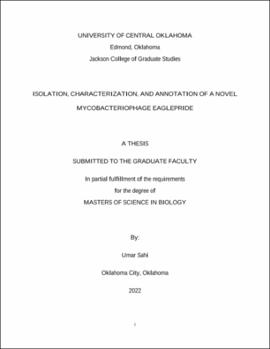| dc.contributor.advisor | Kotturi, Hari | |
| dc.contributor.author | Sahi, Umar | |
| dc.date.accessioned | 2022-06-30T16:56:38Z | |
| dc.date.available | 2022-06-30T16:56:38Z | |
| dc.date.issued | 2022 | |
| dc.identifier.other | (AlmaMMSId)9982867207602196 | |
| dc.identifier.uri | https://hdl.handle.net/11244/335905 | |
| dc.description.abstract | Bacteriophages (phages) are obligate intracellular parasitic viruses that infect bacterial host cells. They are the most abundant biological entity on the planet, with an estimated 1031 viral particles in the biosphere. Bacteriophages play various positions in the biosphere by modulating evolutionary and ecological trends in the local and global microbial communities. These roles include controlling the global bacterial host populations through lytic infections, which are critical for biomass turnover by the lysis-mediated release of nutrients from the microbial biomass into the ecosystem. In marine environments, phages play a crucial role in the biogeochemical cycling process of bacterial species. Phage therapy is an important aspect of bacteriophage research due to the phages' narrow host range and inability to infect eukaryotic cells. The use of phages to control bacterial infections is medically relevant due to the rise of antibiotic-resistant bacteria and the adverse side effects of other forms of therapy. Mycobacteriophages can infect Mycobacterium genus hosts. Mycobacterium smegmatis mc2155 (M. smegmatis) was utilized to isolate mycobacteriophages due to its non-pathogenic and rapid growth properties. The mycobacteriophage Eaglepride was isolated using an enriched soil sample from Ashburn, Virginia (39.014667 N, 77.515417 W). As the soil sample was collected from Eagle Ridge middle school, it was named Eaglepride. The isolation of Eaglepride on host bacteria-seeded 7H10 agar plates produced clear, transparent plaques that were 3 mm in diameter. Electron microscopy imaging of the phage showed a Siphoviridae morphology with a tail length of 175nm, tail width of 20nm, and a head diameter of 55nm. Eaglepride is a temperate phage, capable of using the lytic and lysogenic life cycle. Eaglepride had stable growth at temperatures below 60oC and pH between 6 and 8. Genome annotation showed Eaglepride to be most closely related to phages in the A clusters and A10 subcluster. Eaglepride has a total genomic length of 50,926 bp and a GC content of 64.9%. Eaglepride has 88 open reading frames (ORFs), and the annotated genome sequence is in the GenBank database with an accession number of MZ322017. Eaglepride is not a good candidate for phage therapy due to its narrow host range and its utilization of the lysogenic life cycle. | en_US |
| dc.rights | All rights reserved by the author, who has granted UCO Chambers Library the non-exclusive right to share this material in its online repositories. Contact UCO Chambers Library's Digital Initiatives Working Group at diwg@uco.edu for the permission policy on the use, reproduction or distribution of this material. | |
| dc.subject.lcsh | Bacteriophages | |
| dc.subject.lcsh | Type specimens | |
| dc.subject.lcsh | Therapeutic use | |
| dc.title | Isolation, characterization, and annotation of a novel mycobacteriophage Eaglepride | en_US |
| dc.type | Academic theses | |
| dc.contributor.committeeMember | Olson, Paul | |
| dc.contributor.committeeMember | Vaughan, Melville | |
| dc.thesis.degree | M.S., Biology | |
| dc.subject.keywords | Bacteriophage | |
| dc.subject.keywords | Lysogenic | |
| dc.subject.keywords | Lytic | |
| dc.subject.keywords | Phage | |
| dc.subject.keywords | Prophage | |
| dc.subject.keywords | Superinfection | |
| dc.subject.keywords | Virology | |
| dc.subject.keywords | Microbiology | |
| dc.identifier.oclc | (OCoLC)1333955247 | |
| thesis.degree.grantor | Jackson College of Graduate Studies | |
